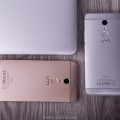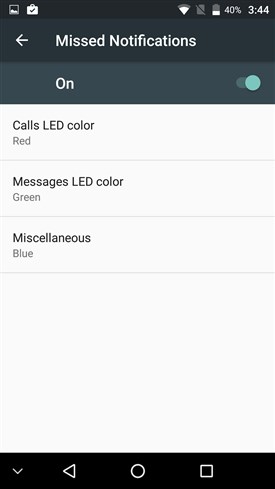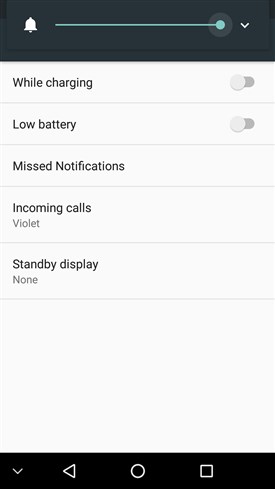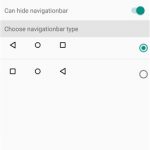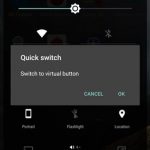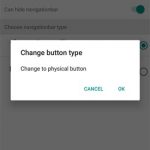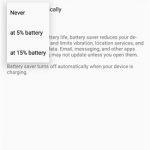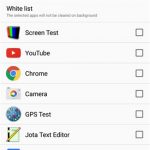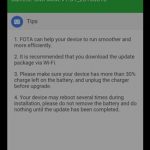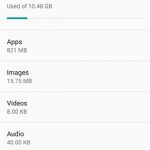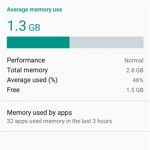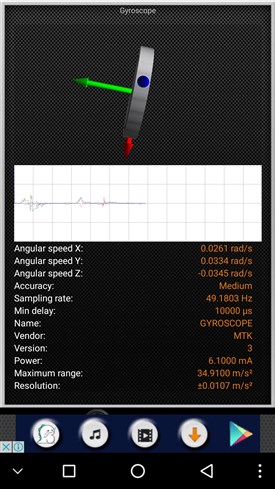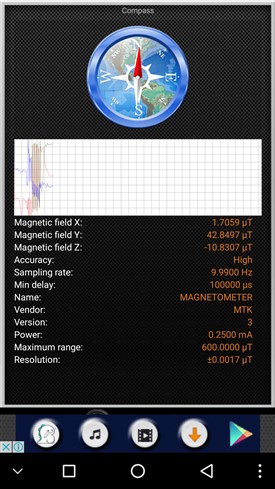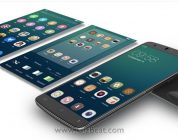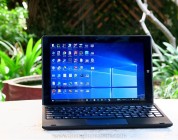UMi Max review Helio P10 MTK6755
The UMi Max is UMi’s “Super Lite”. That is, it’s got the exact same body of the UMi Super, but with lowered specs and price point.
UMi Max review display
One of the highlights of UMi’s recently released mobiles is the display. Used as well in the UMi Max, the display is a Sharp brand 5.5@1080P display.
The only slight negative of this display is some minor vignetting (darkening) on the right side due to LED lighting being on the left, but it’s otherwise exceptional.
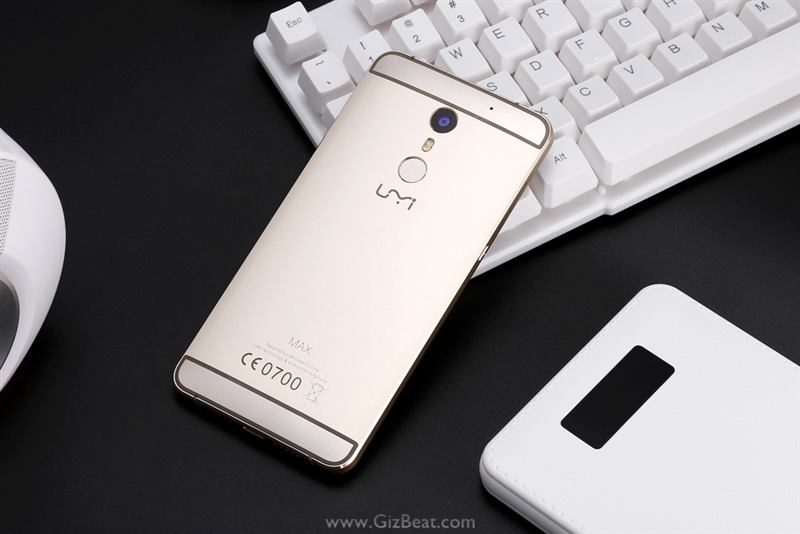
It has great color, pure whites and solid blacks. Text has smooth edges, and even when viewed very closely remains retina smooth.
The display excellently maintains color and contrast at extreme angles. Importantly, shimmer when viewing from top angles is very well controlled. This is one of the best LCDs out there.
Helio P10 UMi Max review GPS
GPS on the UMi Max is good, locking quickly and maintaining 30+ on several satellites and 20+ at several more at any given time.
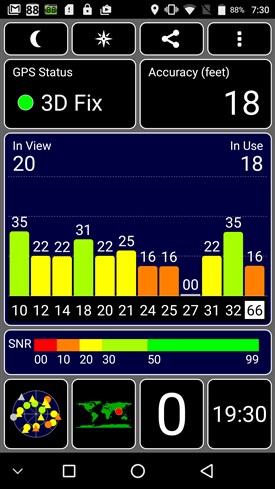
GPS
MTK6755 Helio is in UMi Max
Thankfully, UMi opted to lessen RAM and storage as opposed to SoC. They’ve stuck with the very good mid-budget SoC’s — MT6755 Helio P10. The Helio P10 is the update the the still quite successful and solid MT6753.
The P10 on UMi Max carries 8-core [email protected] which pushes Android smoothly. The GPU is Mali-T880MP2@700MHz which is powerful enough to run the latest 3D games at decent frame rates on a 1080P display.
MTK6755 UMi Max review build and style
The physical build of the UMi Max is very solid. It appears to be the exact same body of the UMi Super. Buttons are firm there’s no give in the back piece.
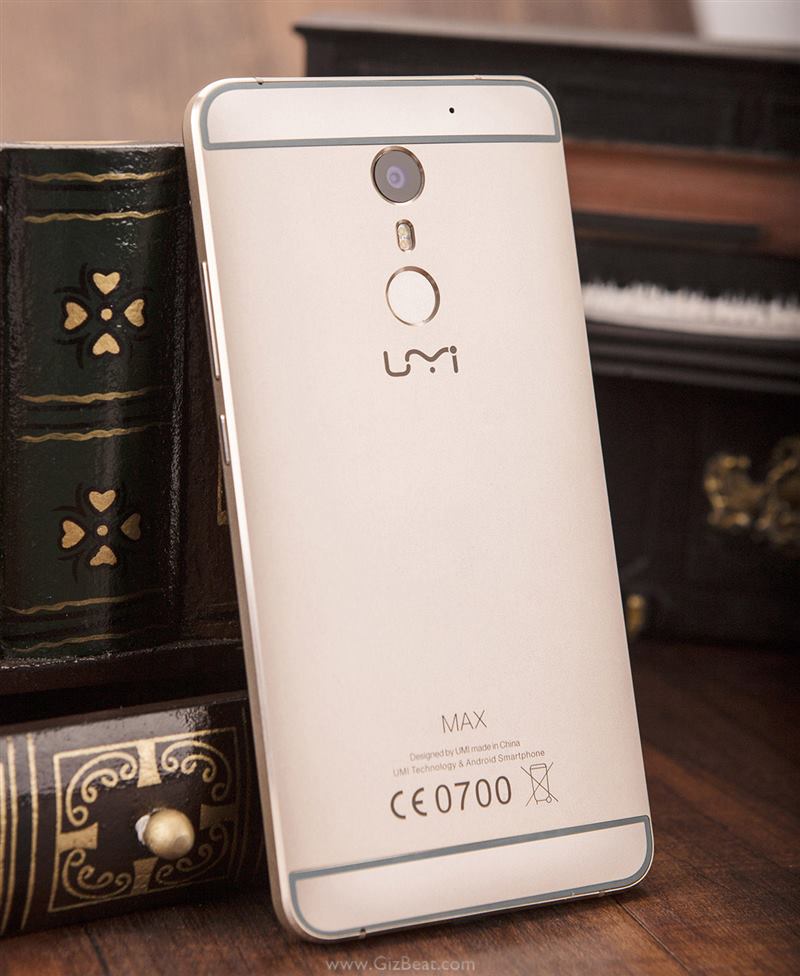
It’s not what you would call a thin and light mobile, but the back and sides are CNC-machined metal and the front glass is 2.5D, which add elements of class to the UMi Max.
The pulsing eye
It pulses slowly, gently, and rhythmically
Also known as the Harlequin LED, this is the most unusual feature of the UMi Max. Rather than a standard pin sized LED, the Max has a pulsing circle where in the middle bottom of the front.
At first we were put off by it, and thankfully UMi has had the foresight to provide a plethora of options. We can disable or change colors for calls, messages, or miscellaneous messages. For low battery and charging the Harlequin LED can be disabled or enabled. It can also be completely disabled so it never pulses.
Unfortunately there’s no way to individually set colors to specific apps, but this could possibly be rigged with a 3rd party app, or UMi may add this in a future OTA. Additionally, you need to clear notifications to make it stop pulsing, but this is a common mistake of China mobiles.
- Pulsing eye
- Pulsing eye
There’s also an option for standby pulsing, which has it continuously pulsing a color of our choice, or to the multi-color “Harlequin” setting. As we said, at first we were put off by the Harlequin eye, but it slowly snuck its way into our approval.
It pulses slowly, gently, and rhythmically; it’s almost hypnotic and has a calming, soothing effect.
One thing that would be great here is an option to adjust the pulsing speed. It pulses slowly now, but could stand to pulses even slower to further decrease obtrusiveness.
UMi Max OS
a very AOSP experience and users of vanilla Android and CM should feel right at home.
The OS on the UMi Max is Android 6.0. UMi has made the very intelligent decision to leave what’s not broke alone; it’s a very AOSP experience and users of vanilla Android and CM should feel right at home.
The UMi Max comes default with onscreen virtual buttons enabled, and UMi has made another smart choice: the capacitive buttons has onscreen virtual buttons for home, menu, and recent apps. UMi has made another smart choice: to have the menu button (the square) open recent apps.
- Reverse virtual buttons
- Virtual / Capacitive quick switch
- Virtual / Capacitive switch
If you prefer capacitive buttons, it can be switched in settings from virtual to capacitive. This option to switch between the two is also available in quick tiles.
Physical action button
A feature which was also carried by UMi Super is the physical action button. This button can be programmed to open any app you choose. It can be quite handy for opening the camera on the fly, or Facebook on the fly, etc…
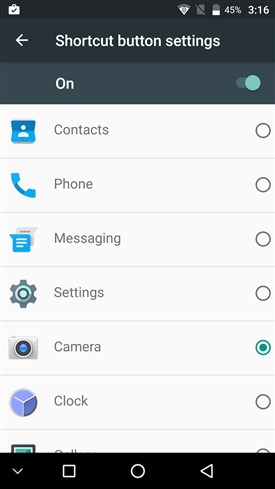
Physical shortcut button
Additional OS notes
- System transitions and animations are very smooth
- Fast typing is quick and without hangups
- Google Play is working without issue
- Adaptive brightness is working fine and adjusts quickly, but transitions between brightness levels a bit sudden rather than smooth
- No force closes during our time with the phone
- Big full selection of quick tiles which can be pulled down via two-finger
- OTA downloaded and installed without issue
- Apps can be whitelisted to not be closed by the system
- RAM is a big 3GB
- Storage is a decent 16GB, with 10GB free for the user
- Low battery mode
- White list stay in memory
- OTA
- Storage
- RAM
UMi Max battery charging
One area UMi Max differs in comparison to UMi Super is the charging. UMi Super had Pump Express 3.0 quick charging, but the UMi Max comes with a 1A charger.
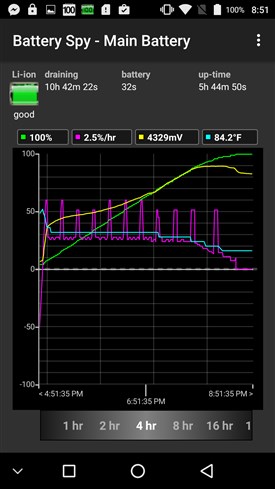
4h charging
Due to the large battery, charging at 5V 1A takes a long 4-5h. Given the large battery and great battery life, the long charging probably won’t be such a big deal to many users, but power users will need to consider this point.
UMi Max battery life SOT screenon time
Running the UMi Max through our 720p WiFi YouTube 140lux test saw the battery lasting an excellent 8h. Assuming medium weight usage, conservatively speaking, users should see about 6 hours SOT over 24 hours. This should be more than most users will need.
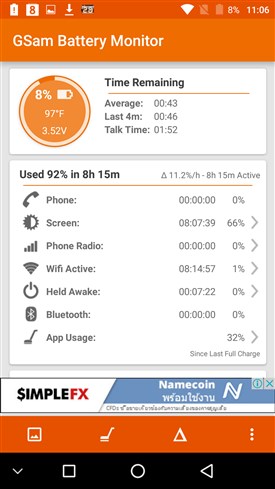
8h SOT screenon
UMi Max review WiFi
WiFi on the UMi Max is excellent. The Max maintained high speeds at a full 144ft/44m with a cinder block wall between the $20 router and the phone.
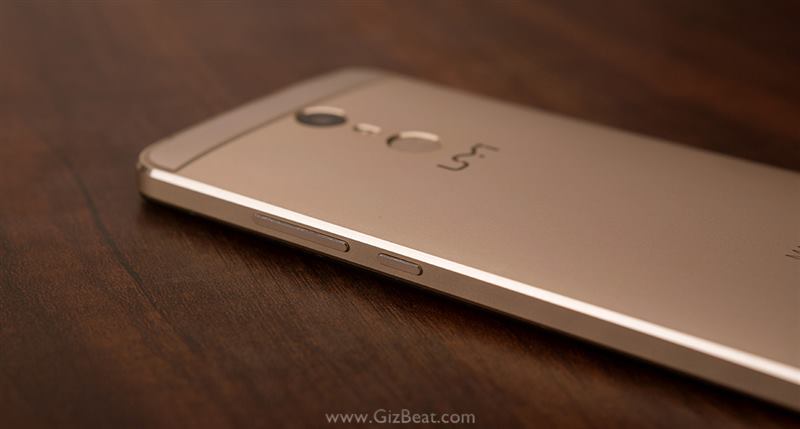
UMi Max external loudspeaker
We were disappointed by the UMi Super speaker, and it appears things have slightly improved with the UMi Max. We wouldn’t say loudness, clarity, and depth are impressive, but it should easily be loud enough for hands free calls and video calls, and pleasant enough for entertainment purposes.
UMi Max review frequency support
- 2G: GSM 850/900/1800/1900MHz
- 3G: WCDMA 850/900/1900/2100MHz
- 4G: FDD-LTE 800/1800/2100/2600MHz
This gives the UMi Max worldwide 2G, worldwide 3G, and 4G LTE for Asia / UK / Euro. With so many China phones only coming with 900/2100 WCDMA, it’s great to see UMi putting 4-band 3G WCDMA in the Max.
UMi Max camera
The UMi Max carries a camera with a 13MP Panasonic sensor. Viewing images with very large crops or at 100% show it’s not quite up to par with the likes of Sony IMX214, Sony IMX258, and Samsung S5K3P3, but it is capable of producing some impressive images (we were particularly impressed with pic #2 in the gallery (HDR)) with good color and is beyond adequate for social sharing.

The images in the gallery are unedited except for reduce and save at 75% jpg quality.
UMi Max gyroscope and compass
This might be the most inexpensive recent MTK MediaTek device to carry a compass and a gyroscope.
Good job UMi. This might be the most inexpensive recent MTK MediaTek device to carry a compass and a gyroscope.
Whether it’s a side effect of using the UMi Super innards, or a purposeful move by UMi, it’s a good thing.
A compass, though not necessary, can be useful for navigation, especially when walking and not sure which direction you’re facing in Maps.
- Gyroscope
- Compass
The gyroscope has several useful functions, but what we really love it for is Google Camera panoramas which aren’t possible without a gyroscope.
Note Google Camera will force close the first few opens as you swipe through the introductory screens saying it “can’t connect to the camera” or similar. Keep opening it. On the 3rd open it should be good to go from there.
UMi Max OTG
OTG is working no problem on the UMi Max. We tested a keyboard, generic gamepad, and Bluetooth mouse.
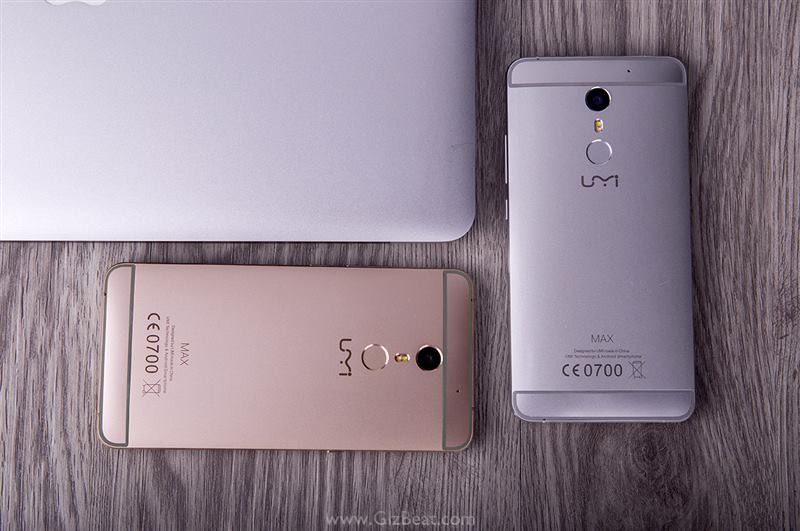
UMi Max summary conclusion
This is tough. The UMi Max is a good phone, with a great display and battery life. They’ve also done a lot of things right with the OS, such as easy changing from virtual to capacitive navigation buttons, a clean and smooth AOSP Android, multiple notification LED controls, and a big selection of quick tiles.
Where it misses excellence is with battery charging, and the camera could have been a step better. They’re fine and fairly typical of other devices in this price range, but Max could have been a top pick had they put 1.5A charging and Sony IMX214 for example.
Mi Max comes stock with Global AOSP vanilla Android, great battery life, manly style, a beautiful display, gyroscope, compass, 2.5D front glass, a good camera, 3GB RAM, big 32GB storage, the great Helio P10, and the unique pulsing eye.
$139.99 Redmi Note 3 [email protected]
We would easily use UMi Max as our main mobile and think the UMi Max is a good choice at $150 or less. The highlights are great battery life, quick vanilla AOSP Android 6, and a great display with incredible smoothness, excellent colors, and impressive blacks and whites.
The Xiaomi Redmi Note 3 Pro (RN3P), our GizBeat top pick might be a better choice for some users depending on what’s most important to you. RN3P can be had for an incredible $139.99 now from Banggood. We like the display and AOSP Android on UMi Max, but the RN3P’s got a better camera, better battery life, faster charging, tons of custom ROMs, and a huge community of support behind it.
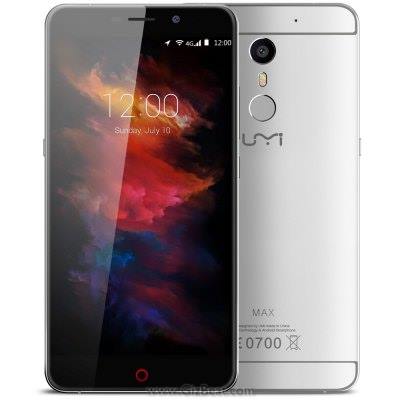
Max
Jumping on the Xiaomi “Max” bandwagon along with Cubot, is Umi, with the Umi Max. Though some might argue that Umi got there first with their 2015 release of the “eMax”. Don’t be confused though, the Umi Max and Umi eMax are 2 entirely different phones.
Umi Max specs:
- Display: Sharp 5.5 inch Corning Gorilla Glass 3 FHD screen
- SoC: Helio P10 Octa Core 1.8GHz
- System: Android 6.0
- RAM + ROM: 3GB RAM + 16GB ROM
- Max Storage Expansion: 256GB
- Camera: Back camera 13.0MP with flashlight + front camera 5.0MP
- Bluetooth: 4.1
- GPS: GPS
- OTG: Yes
- Gorilla Glass 3: Yes
- Compass: Yes
- Fingerprint sensor: Yes
- TF SD expandable: Yes (*TF-SD+Single-SIM or Dual-SIM)
- Sensor: G-sensor, Proximity sensor, Ambient light senor
- SIM Card: (*) Dual SIM dual standby, dual Micro SIM cards
- Network:
- 2G: GSM 850/900/1800/1900MHz
- 3G: WCDMA 850/900/1900/2100MHz
- 4G: FDD-LTE 800/1800/2100/2600MHz
No, your eyes aren’t deceiving you. This is the same body as Umi Super, but with slightly different specs.

We appreciate this move, as it brings the great Sharp LTPS display and Helio P10 down to a more affordable level, though perhaps Super Lite may be a better name than Max.
The difference between Umi Super and Umi Max, are that Umi Max has decreased RAM and storage compared to Super (3GB/16GB v 4GB/32GB). We don’t find this to be a huge compromise, and think the majority of users will be more than fine with 16gb and the expandable storage. The loss of 1GB RAM here is a non-issue.

